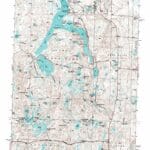Want to delve into the intricacies of Teton County’s landscape? Whether you’re interested in property lines, environmental data, or simply exploring this stunning region, understanding Geographic Information Systems (GIS) is key. This guide is your comprehensive resource for navigating the world of Teton GIS, offering insights into its applications, benefits, and potential future.
Exploring Teton GIS
Teton GIS, or Geographic Information System, offers a powerful digital lens for exploring the Teton landscape. It reveals a wealth of information, from property boundaries and land use to crucial environmental data. This guide will help you navigate the world of Teton GIS, whether you’re in Wyoming or Idaho.
Wyoming’s GIS Portal
Teton County, Wyoming, provides a comprehensive GIS platform, offering a digital gateway to geographic information. This interactive platform allows users to explore property ownership, land usage patterns, and other location-based services. The county’s commitment to maintaining up-to-date technology is evident in their ongoing platform upgrades. Explore their official website and the user-friendly Experience Builder App for a wealth of information.
Idaho’s Open Data Initiative
Across the state line, Teton County, Idaho, also provides valuable GIS resources. Their online map gallery and open data portal offer accessible information, including a popular address and parcel viewer map. This interactive tool, created by a dedicated GIS professional, has garnered over half a million views, demonstrating its value to the community. Visit their official GIS website to explore this resource.
Conservation through GIS: The Teton Conservation District
The Teton Conservation District uses GIS for environmental stewardship, creating, analyzing, and visualizing geospatial data for conservation projects. They offer expertise in applying GIS technology to conservation efforts and can provide guidance on related projects. Learn more about their impactful work on their website.
ESG and Location: The RepRisk Approach
RepRisk connects Environmental, Social, and Governance (ESG) factors with location data. This enables organizations to assess and manage risks related to biodiversity and other ESG concerns, highlighting the connection between environmental risks and financial impacts. (Sponsored content) Discover more about their services on their website.
Comparing Wyoming and Idaho’s GIS Platforms
While both Wyoming and Idaho offer valuable GIS resources, their approaches differ. Wyoming provides a centralized hub for comprehensive geospatial data, including detailed property information and interactive maps. Idaho emphasizes open data access and a user-friendly address/parcel viewer. Each system could potentially benefit from the other’s strengths. Wyoming could perhaps adopt a more open data approach, while Idaho could incorporate more interactive mapping features.
Practical Applications of Teton GIS
Teton GIS empowers informed decision-making, playing a crucial role in conservation efforts. It enables experts to manage wildlife habitats, track invasive species, and plan for sustainable land use, such as tracking elk migration routes or mapping wildfire-prone areas.
The Future of Teton GIS: ESG Integration
Integrating ESG data with Teton GIS unlocks exciting new possibilities, such as overlaying environmental risk data onto property maps. This empowers developers, conservationists, and policymakers to make responsible choices, fostering a sustainable future for the Teton region.
| Feature | Teton County, WY | Teton County, ID | Teton Conservation District | RepRisk |
|---|---|---|---|---|
| Main Focus | Public Information & Parcel Data | Open Data & Parcel Viewing | Conservation & Mapmaking | ESG & Location-Based Risk |
| Key Tools & Features | Interactive Maps, Parcel Data, Web GIS Platform | Map Gallery, Open Data Portal, Address/Parcel Viewer | Creating & Analyzing Geospatial Data | Integrating ESG Data, Risk Reports |
| Who It’s For | General Public, Professionals | General Public, Professionals | Conservationists, Researchers | Businesses, Investors |
Explore other regional GIS resources: Discover the wealth of data available through Tazewell County IL GIS and explore the interactive maps and visualizations provided by the Tuscaloosa County GIS platform.
Google Maps vs. True GIS
Is Google Maps a GIS? It uses some similar underlying principles, but its primary focus is navigation, not deep geographical analysis. It’s like comparing a pocket knife to a chef’s knife set – both are useful, but for different purposes. While Google Maps provides basic location-based services, it lacks the powerful data manipulation and analysis tools of a true GIS. Some sources, like the North Carolina Educational Standards for Earth and Environmental Science (NCESC), suggest categorizing Google Maps as a simplified GIS, but this might be an oversimplification. It displays spatial data and offers location-based services, but does it truly meet all the criteria of a full GIS? The research suggests probably not.
Key Differences
A true GIS offers extensive customization, allowing for specialized analyses. Users control their data, integrating diverse sources like satellite imagery. Google Maps relies primarily on Google and user-generated content. A true GIS also provides advanced spatial analysis, statistical modeling, and complex queries, while Google Maps offers basic measurements and simple overlays.
| Feature | Google Maps | True GIS |
|---|---|---|
| Primary Purpose | Navigation, Location Services | Creating, Analyzing, and Visualizing Geographic Data |
| Typical Users | General Public | Professionals, Researchers |
| Level of Customization | Limited | Extensive |
| Data Control | Primarily Google/User-Generated | User-Managed, Diverse Sources |
| Analytical Capabilities | Basic measurements | Advanced spatial analysis, modeling |
Bridging the Gap
New platforms are constantly emerging to bridge the gap between Google Maps’ simplicity and the power of a full GIS. These platforms offer more advanced features without sacrificing user-friendliness, influencing the evolution of GIS and pushing developers towards intuitive design and accessibility.
The Broader Impact
Google Maps plays a vital role in the world of geographic data. By integrating with other services, it influences how data is shared and used in various fields. Ongoing research suggests the lines between simple mapping tools and powerful GIS software may continue to blur.
Teton County’s Wealth
Teton County, Wyoming, consistently ranks as America’s wealthiest, often surpassing Pitkin County (Aspen). This enduring economic strength isn’t solely due to tourism; it’s fueled by a new economic model centered around the “great outdoors.” This includes thriving outdoor gear companies, adventure tourism outfitters, and a real estate market catering to those seeking a piece of the wilderness. This model likely suggests a shift in wealth creation, moving towards environmentally rooted experiences.
Teton County regularly tops the list in per capita income. In 2021, it reached $318,297, with estimates suggesting it might have reached $406,054 by 2024. This is driven by tourism and high-net-worth individuals attracted to the region’s unique blend of natural beauty and recreational opportunities.
This prosperity, however, has created a significant wealth disparity. The housing crisis impacts an estimated 95% of local businesses, posing a challenge to the long-term economic sustainability. The question remains: can this growth coexist with community well-being? Experts are debating solutions, including addressing the housing crisis and exploring alternative economic models. The allure of the “great outdoors” must not overshadow the struggles of local residents.
Teton County’s Identity
Teton County, Wyoming, is a blend of breathtaking landscapes and rich human history. It’s more than just a location; it’s an experience.
Grand Teton National Park
Grand Teton National Park is a 310,000-acre sanctuary teeming with life, from the rugged peaks of the Teton Range to the clear waters of Jenny and Jackson Lakes. Over 200 miles of trails offer various adventures, from lakeside strolls to challenging climbs.
Jackson Hole: Beyond Skiing
While renowned for world-class skiing, Jackson is more than a winter destination. It’s a town rich in Western history and contemporary charm, with art galleries, boutiques, and upscale dining. The Million Dollar Cowboy Bar, with its saddle barstools, offers a taste of Western tradition.
Luxury Living
Teton County is known for luxury living, with resorts like Amangani and the Four Seasons offering breathtaking views and refined experiences.
Community and Conservation
Teton County has a strong sense of community, with local organizations actively involved in conservation. Farmers markets and festivals celebrate the region’s spirit, and sustainability is a core value.
Balancing Growth and Preservation
A key challenge for Teton County is balancing growth with preserving its natural beauty. Open discussions and sustainable practices are key to ensuring its future as a treasured destination. Some experts believe controlled development and strict environmental regulations are essential, while others advocate for eco-tourism and responsible land use. Ongoing research and community dialogue are crucial for finding the best path forward.
Teton County is a dynamic place where natural wonders meet human aspirations. It’s a place of constant evolution, where the community strives to create a future that honors both its rich past and breathtaking present. It is where the Tetons meet the Snake River, luxury and wilderness coexist, and appreciation for nature underpins a vibrant community. This is Teton County’s unique identity.
- Unlock 6000+ words beginning with he: A comprehensive analysis - April 20, 2025
- Mastering -al Words: A Complete Guide - April 20, 2025
- Master Scrabble: High-Scoring BAR Words Now - April 20, 2025

















2 thoughts on “Unlocking Teton County’s Landscape: Your Guide to GIS Mapping, Property Data, and Environmental Insights”
Comments are closed.